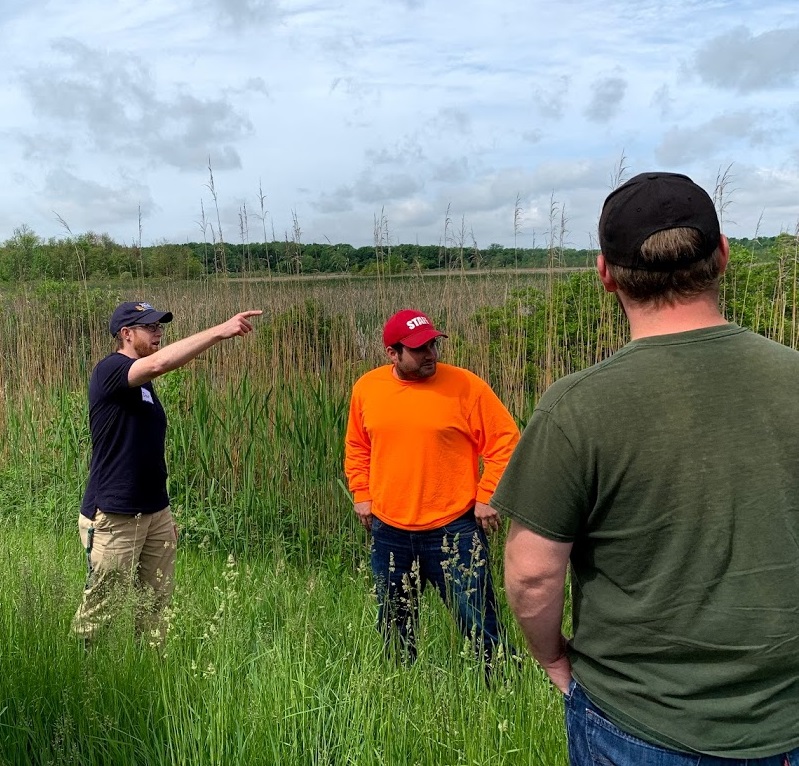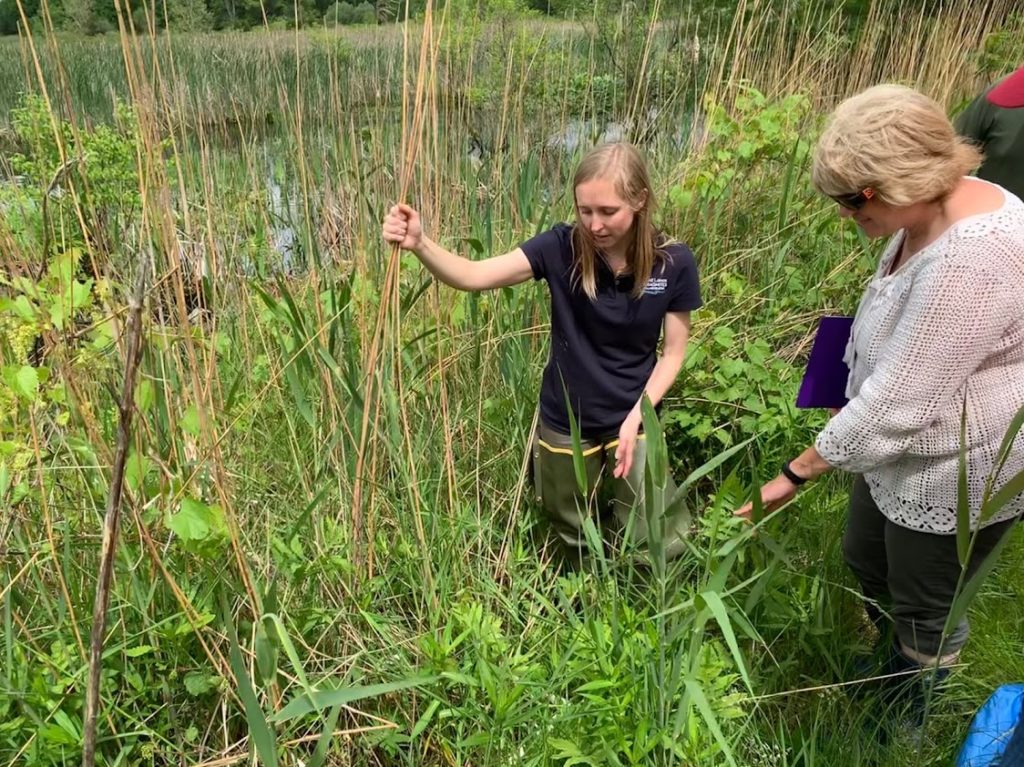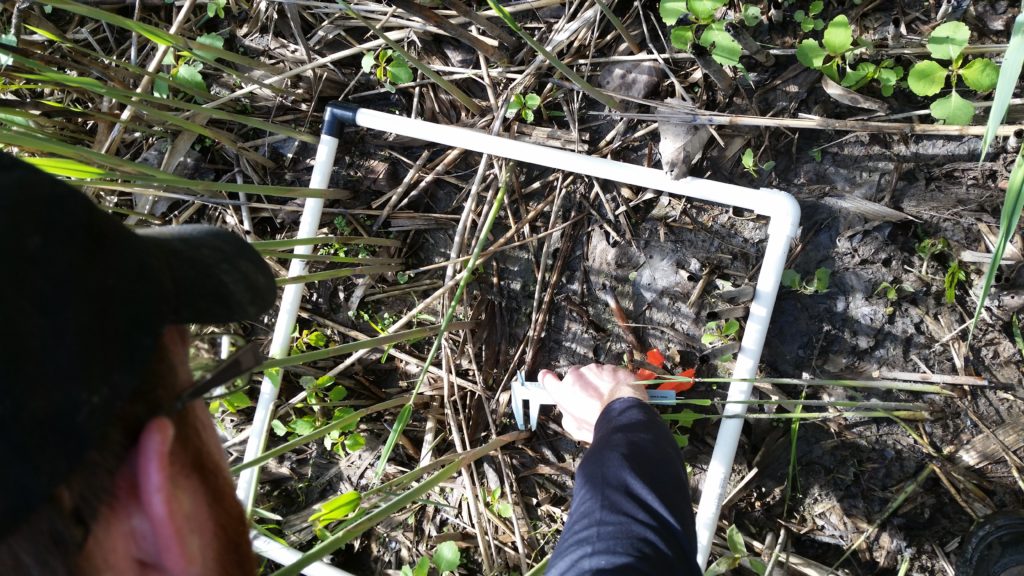December 23, 2019 – Patrick Canniff, Great Lakes Commission
As we reach the end of Phragmites translocation phase and the start of the dormant phase, it’s a good time to take a moment to celebrate the things that we’ve accomplished this past year and reflect on those things that maybe did not go quite as we planned. This is a time to both plan for the coming year, repeat our successes, and to adjust for the 2020 field season to do it all again!

Image 1. PAMF staff lead field training session, summer 2019.
PAMF is also taking a moment to reflect and evaluate. We want to ensure the wonderful “PAMFers” that make this program a success continue to benefit from their participation and collectively help to reduce the prevalence of invasive Phragmites throughout the Great Lakes region. To adapt PAMF to participant needs, we distributed a questionnaire to all participants and to those who attended last year’s training sessions. Responses from this questionnaire will been used to help make the PAMF program easier to participate in, more useful for participants, and guide changes into the future. Thank you to all the participants who took the time to respond to the survey!
A total of 38 questionnaire responses were received. Half of the respondents were actively enrolled in PAMF and had submitted all reporting information this past cycle. The remaining half were not actively enrolled in PAMF; this includes those who did not submit data this past cycle and those that attended a PAMF training but did not enroll a management unit for the 2019/20 cycle. The largest percentage of respondents (23.7%) work for a state or provincial government agency; 21.1% of respondents work for a non-profit organization; 18.4% of respondents work for a local government agency; and 15.8% of respondents work for a CISMA, CWMA, or PRISM (Figure 1).

Figure 1. Survey responses were received from many different organizations, representing the diversity of stakeholders and Phragmites managers currently enrolled in the PAMF program.
Insights
Respondents who attended a training but did not enroll a unit reported multiple barriers to participation in PAMF this cycle. The most common barriers were staff capacity, timing of management guidance, Phragmites as a low management priority, and lack of funding (Figure 2). A lack of staff capacity and the timing of management guidance distribution were the highest barriers to engagement for 68% non-participant respondents and 67% respondents who are not currently engaged (i.e., those who had previously participated in PAMF but did not in 2018/19), indicating that these two factors are the most likely to determine participation, and are of the highest priority for PAMF to address for the 2020 cycle.

Figure 2. A total of 16 respondents attended a PAMF training but did not enroll a management unit in the 2018/19 cycle
When asked what would have enabled participation in PAMF for those that attended PAMF trainings but did not enroll, the most common feedback was both “a site visit from the PAMF team to assist with enrollment and/or annual monitoring” and “assistance submitting data on the Web Hub.” Good news – we will be offering site visits to assist in enrollment and annual monitoring in 2020!

Image 2. Site visit with PAMF staff, assisting with monitoring protocol in field.
PAMF staff hosted seven training sessions this year across the Great Lakes region. According to respondents who attended training sessions in 2019, the most valuable parts of attending (other than the free lunch!) were exposure to PAMF, the in-field demonstration of PAMF enrolling and monitoring, and the opportunity to ask questions to PAMF staff (Figure 3). We were glad to receive so much constructive feedback on the training sessions and are glad potential participants find them valuable. We have decided to host another round of training sessions in 2020! If you are interested in hosting a training session in your area, contact the PAMF coordinator today at pamf@glc.org!

Figure 3. A total of 22 respondents attended a PAMF training in the 2018/2019 cycle, including both those who did and did not ultimately enroll a management unit with PAMF.
We hear you!
As stated above, the most commonly reported difficulties with participation in PAMF were due to staff capacity and time commitments. PAMF is not meant to be a significant time commitment, and the expected overall annual time commitment is 3-5 hours to collect and report data. We have designed our data collecting protocols to be robust and straightforward, and current participants reported in the questionnaire that they encountered few problems with data collection or enrollment. To assist future participants, PAMF staff have developed a list of tips for submitting high-quality data, as well as a series of How-To videos that will walk you through enrolling management units and monitoring those management units as a PAMF participant.

Image 3. Demonstration of the monitoring protocol, measuring stem diameter in one of five quadrats.
We hope to see you at one of our 2020 PAMF training sessions!
Thanks for a great 2018/19 cycle!
Not already involved? Join PAMF today!
